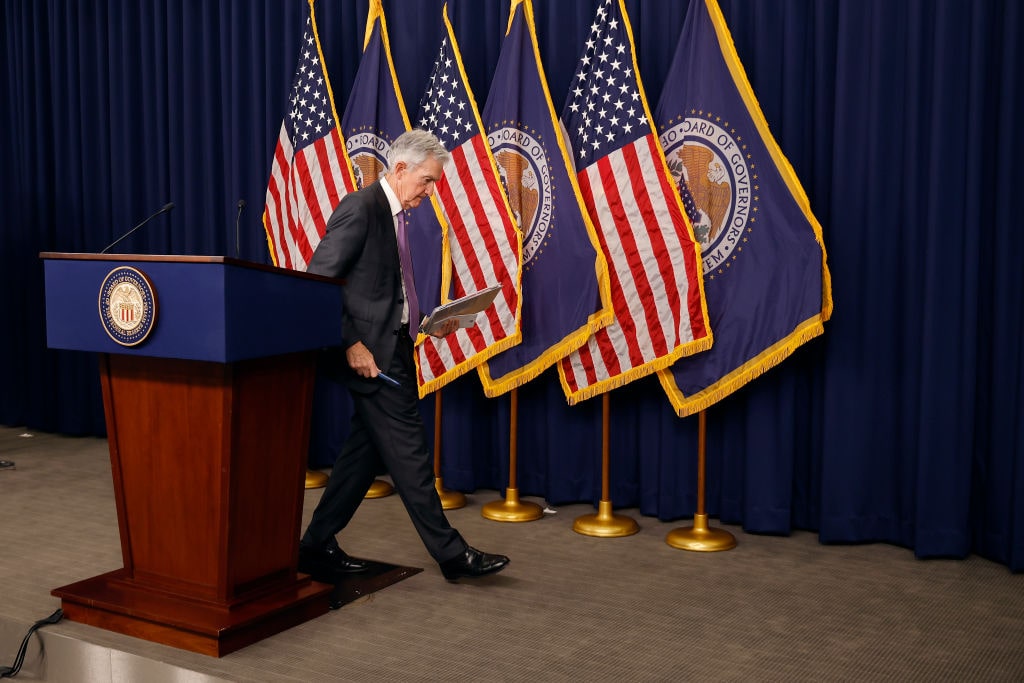Unsurprisingly, the Federal Reserve kept 23-year-high interest rates unchanged at the March Federal Open Market Committee (FOMC) policy meeting. What was notable from the latest powwow of monetary authorities was central bank chief Jerome Powell confirming that his associates will cut rates three times this year, come hell or high water. But while the Fed head attempts to depict himself as Paul Volcker, his actions are comparable to Arthur Burns.
Jerome Powell Feels the Burns
The rate-setting Committee released the updated Summary of Economic Projections (SEP), signaling that the Fed plans to employ three quarter-point rate cuts this year and lowering the median policy rate to 4.6%. According to the merry money printers at the United States Central Bank, even as recent data suggest a second round of inflation, the rates are coming down just in time for the 2024 election.
 The adjusted SEP data was compelling because officials pushed back rate fears to next year and beyond. In December, Fed members anticipated that the median policy federal funds rate (FFR) would decline to 3.6% in 2025 and 2.9% in 2026. However, the March forecasts were revised to 3.9% and 3.1%, respectively. The longer-run median policy rate was also increased from 2.5% to 2.6%. If occupants inside the Eccles Building are satisfied with the current progress and inflation will meet the institution’s 2% target, why bother keeping rates higher for longer?
The adjusted SEP data was compelling because officials pushed back rate fears to next year and beyond. In December, Fed members anticipated that the median policy federal funds rate (FFR) would decline to 3.6% in 2025 and 2.9% in 2026. However, the March forecasts were revised to 3.9% and 3.1%, respectively. The longer-run median policy rate was also increased from 2.5% to 2.6%. If occupants inside the Eccles Building are satisfied with the current progress and inflation will meet the institution’s 2% target, why bother keeping rates higher for longer?
With back-to-back hotter-than-expected inflation readings, Powell told reporters during the post-meeting press conferences that it remains to be seen if these were bumps in the road or something else entirely. It is unclear whether it is a repeat of the 1980s or a matter of seasonal adjustments. What raises some eyebrows and furrows various brows is that the changes to the SEP manufactured by Jerome Powell and Co. make little sense. Of course, unless the entity considered the November election and caved under the political pressure applied by the White House.
Democrats Unhappy
Nearly two dozen progressive Democrats in both chambers of Congress, including Sen. Elizabeth Warren (D-MA) and Rep. Pramila Jayapal (D-WA), penned a letter to Jerome Powell demanding that he cut interest rates immediately. They noted that President Joe Biden’s policies have successfully tackled inflation while supporting economic growth. However, housing affordability has metastasized into a crisis because rates are so high, and higher-for-longer borrowing costs could impact workers’ earnings. The letter stated:
“With core inflation already having come into line with the Federal Reserve’s target, today’s excessively contractionary monetary policy needlessly worsens housing market imbalances and the unaffordability of home ownership, creates risks for banking stability, and could threaten the achievements of strong employment and wage growth and its attendant reductions in economic and racial inequalities.
“The more realistic concern in light of these labor-market trends is that the Federal Reserve may wait too long to lower rates and allow tight monetary policy to reduce employment and real wage growth.”
Speaking at a campaign rally in Philadelphia, PA, earlier this month, President Biden told the crowd that the Fed would cut rates soon. “I can’t guarantee it. But I bet – you betcha – those rates come down more because I bet you that that little outfit that sets interest rates, it’s going to come down,” he said. This comes after the president urged the central bank to no longer raise rates in December.
 Is history repeating itself, or is it, as Mark Twain wrote, rhyming? A chorus of Fed officials says they do not want to relive the 1980s, when inflation kept returning, forcing the central bank to respond with rate hikes. But while Powell tries to be as stern as Volcker in the 1980s, he is on the cusp of being as lenient as Arthur Burns if he follows through on rate cuts.
Is history repeating itself, or is it, as Mark Twain wrote, rhyming? A chorus of Fed officials says they do not want to relive the 1980s, when inflation kept returning, forcing the central bank to respond with rate hikes. But while Powell tries to be as stern as Volcker in the 1980s, he is on the cusp of being as lenient as Arthur Burns if he follows through on rate cuts.
Burns served as Fed Chair from 1970 to 1978 under three presidents and was vulnerable to political pressure. “I’m counting on you, Arthur, to keep us out of a recession,” then-President Richard Nixon told Burns. The 10th Fed Chair had to balance sustaining growth, keeping a lid on inflation, ensuring low rates, facilitating a climate of easy access to credit, and making politicians happy. The results? A disaster. Under Burns, whom his successors described as someone who was a part of administrations rather than an independent figurehead, there was intense volatility in the consumer price index, the FFR followed in the footsteps of inflation directions, and the money supply continued to grow rather than contract.
The situation spiraled out of control, leading to the formation of the Nixon Shock, a series of measures involving price and wage controls, tariffs, and the official end to the gold standard. While critics blamed Nixon for Burns’ dereliction of duty, the flip-flops were prevalent until his final days at the Fed helm.
Despite claims of independence, the Fed continues to heed the calls of the executive branch and serves as Congress’ banker. As for Jerome Powell, he listened to former President Donald Trump’s requests and cut the FFR by 25 basis points to juice the economy. In the final eight months of 2024, he could repeatedly slash the benchmark rate at a time when inflation and the Fed’s various preferred gauges remain above trend and traveling in an upward trajectory.
Fed Up
Is Jerome Powell the problem or the Federal Reserve System? Whether under Alan Greenspan or Janet Yellen, the central bank is the most powerful organization in the world that crafts booms and busts through interventions, distortions, and manipulations. Despite its omnipotence and might, the Fed has eviscerated 98% of Americans’ purchasing power, fueled Washington’s debt appetite, bailed out bad banks, and caused the great bubbles of the 21st century. No matter who is steering the ship, this will always be the case while politics rules at the Fed.




